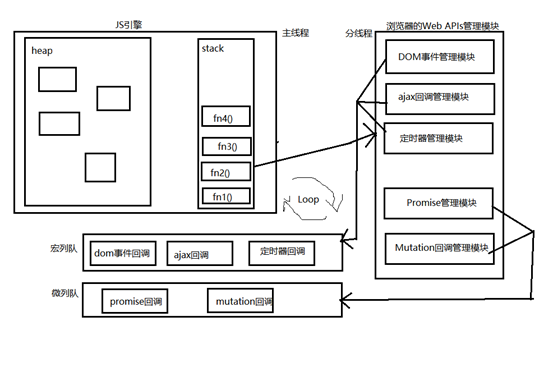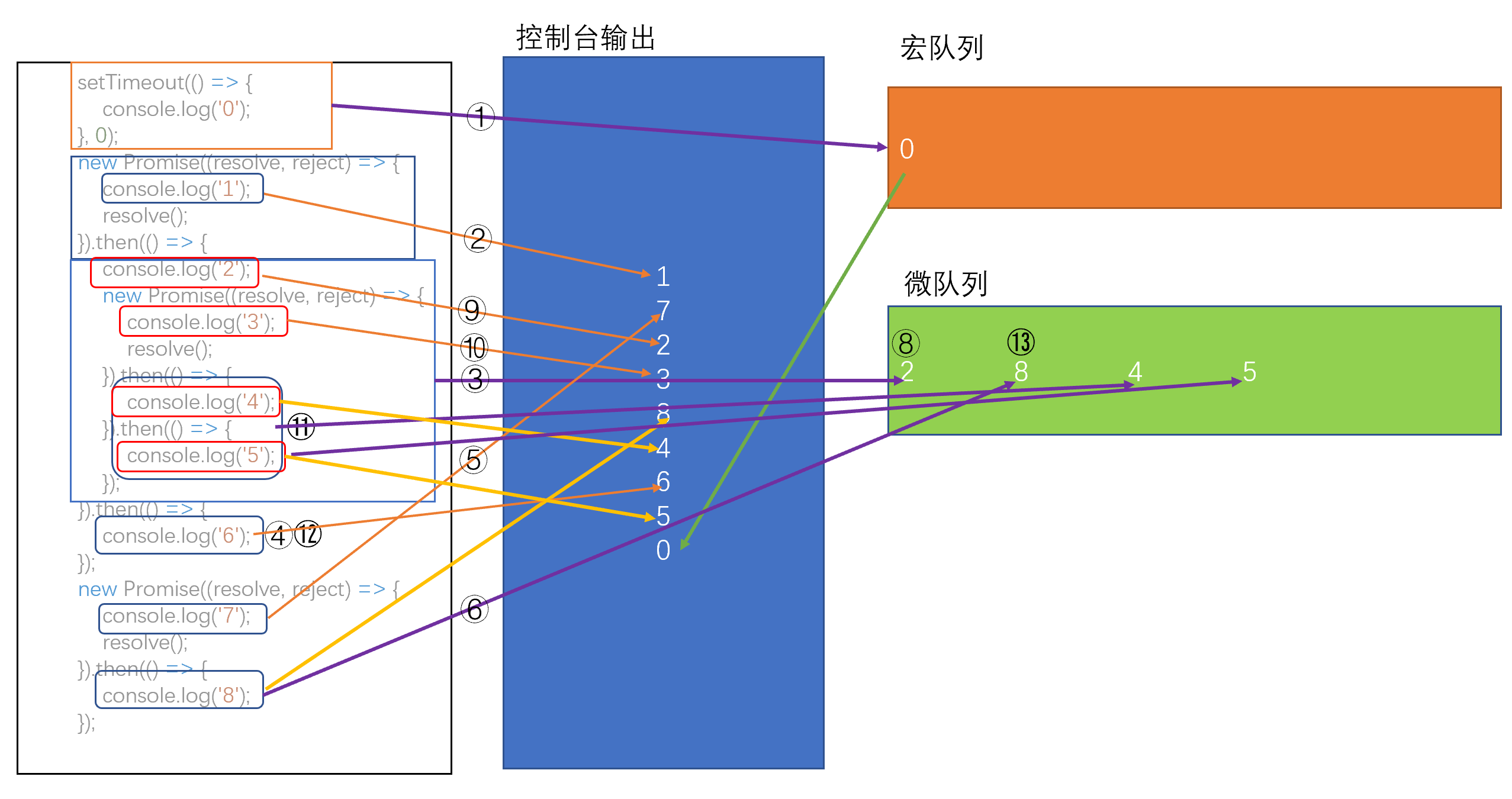Promise
前置知识
回调函数的分类
我们定义的,我们没有调用,最终执行了
同步的回调函数: 立即在主线程上执行,不会放入回调队列中。例:数组遍历相关的回调函数。
异步的回调函数: 不会立即执行,会放入回调队列中以后执行。例:定时器回调/Ajax回调
js中的error
错误的类型:
- Error: 所有错误的父类型
- ReferenceError: 引用的变量不存在
- TypeError: 数据类型不正确
- RangeError: 数据值不在其所允许的范围内--死循环
- SyntaxError: 语法错误
错误处理
- 捕获错误:
try{}catch(){} - 抛出错误:
throw error
错误对象
message属性: 错误相关信息stack属性: 记录信息
Promise 是什么?
抽象表达
- Promise是一门新的技术(ES6提出的)
- Promise是JS中异步编程的新方案(旧方案是谁?---纯回调)。
具体表达
- 从语法上来说: Promise是一个内置构造函数。
- 从功能上来说: Promise的实例对象可以用来封装一个异步操作,并可以获取其成功/失败的
- Promise不是回调,是一个内置的构造函数,是程序员自己new调用的。
new Promise的时候,要传入一个回调函数,它是同步的回调,会立即在主线程上执行,它被称为executor函数- 每一个Promise实例都有3种状态:初始化(
pending)、成功(fulfilled)、失败(rejected) - 每一个Promise实例在刚被new出来的那一刻,状态都是初始化(
pending) executor函数会接收到2个参数,它们都是函数,分别用形参:resolve、reject接收- 调用
resolve函数会:让Promise实例状态变为成功(fulfilled),可以指定成功的value。 - 调用
reject函数会:让Promise实例状态变为失败(rejected),可以指定失败的reason。
- 调用
基本使用
重要语法:new Promise(executor)构造函数 Promise.prototype.then方法
基本编码流程
- 创建Promise的实例对象(pending状态), 传入executor函数
- 在executor中启动异步任务(定时器、ajax请求)
- 根据异步任务的结果,做不同处理:
- 如果异步任务成功了: 我们调用resolve(value), 让Promise实例对象状态变为成功(fulfilled),同时指定成功的value
- 如果异步任务失败了: 我们调用reject(reason), 让Promise实例对象状态变为失败(rejected),同时指定失败的reason
- 通过then方法为Promise的实例指定成功、失败的回调函数,来获取成功的value、失败的reason 注意:then方法所指定的:成功的回调、失败的回调,都是异步的回调。
关于状态的注意点:
- 三个状态:
- pending: 未确定的------初始状态
- fulfilled: 成功的------调用resolve()后的状态
- rejected: 失败的-------调用reject()后的状态
- 两种状态改变
pending ==> fulfilledpending ==> rejected - 状态只能改变一次!!
一个promise指定多个成功/失败回调函数, 都会调用吗?
const p = new Promise((resolve, reject) => {
const xhr = new XMLHttpRequest();
xhr.onreadystatechange = () => {
if (xhr.readyState === 4) {
if (xhr.status >= 200 && xhr.status < 300) {
resolve(xhr.response);
} else {
reject('请求出错');
}
}
}
xhr.open('GET', 'https://api.apiopen.top/getJoke');
xhr.responseType = 'json';
xhr.send();
});
p.then(
(value) => {
console.log(value);
},//成功的回调--异步
(reason) => {
console.log(reason);
}//失败的回调--异步
);
console.log('hello');
API
Promise构造函数
new Promise (executor) {}
executor函数: 是同步执行的,(resolve, reject) => {}resolve函数: 调用resolve将Promise实例内部状态改为成功(fulfilled)。reject函数: 调用reject将Promise实例内部状态改为失败(rejected)。
executor函数会在Promise内部立即同步调用,异步代码放在executor函数中。
Promise.prototype.then方法
Promise实例.then(onFulfilled,onRejected)
onFulfilled: 成功的回调函数(value) => {}onRejected: 失败的回调函数(reason) => {}
then方法会返回一个新的Promise实例对象
const p = new Promise((resolve, reject) => {
setTimeout(() => {
resolve(100);
}, 1000)
})
const x = p.then(
value => {
console.log('成功了', value)
},
reason => {
console.log('失败了', reason)
}
)
console.log(x); // Promise {<pending>}
Promise.prototype.catch方法
Promise实例.catch(onRejected)
onRejected: 失败的回调函数 (reason) => {}
catch方法是then方法的语法糖, 相当于: then(undefined, onRejected)
const p = new Promise((resolve, reject) => {
setTimeout(() => {
reject(-1)
}, 1000)
})
p.then(
value => {
console.log('成功了', value)
},
reason => {
console.log('失败了1', reason)
}
)
p.catch(
reason => {
console.log('失败了2', reason)
}
)
Promise.resolve方法
Promise.resolve(value)
用于快速返回一个状态为 fulfilled 或 rejected 的Promise实例对象
value的值可能是:(1)非Promise值 (2)Promise值
const p0 = Promise.reject(-100);
const p = Promise.resolve(p0);
p.then(
value => {
console.log('成功了', value)
},
reason => {
console.log('失败了', reason)
}
)
Promise.reject方法
Promise.reject方法(reason)
用于快速返回一个状态必为 rejected 的Promise实例对象
const p0 = Promise.resolve(100);
const p = Promise.reject(p0);
p.then(
value => {
console.log('成功了', value)
},
reason => {
console.log('失败了', reason)
}
)
Promise.all方法
Promise.all(promiseArr)
promiseArr: 包含n个Promise实例的数组
返回一个新的Promise实例, 只有所有的promise都成功才成功, 只要有一个失败了就直接失败。
const p1 = Promise.resolve('a');
const p2 = new Promise((resolve, reject) => {
setTimeout(() => {
reject('b')
}, 500)
})
const p3 = new Promise((resolve, reject) => {
setTimeout(() => {
resolve('c')
}, 2000)
})
const x = Promise.all([p1, p2, p3]);
x.then(
value => {
console.log('成功了', value)
},
reason => {
console.log('失败了', reason)
}
)
Promise.race方法
Promise.race(promiseArr)
promiseArr: 包含n个Promise实例的数组
返回一个新的Promise实例, 成功还是很失败?以最先出结果的promise为准。
const p1 = Promise.resolve('a');
const p2 = new Promise((resolve, reject) => {
setTimeout(() => {
reject('b')
}, 500)
})
const p3 = new Promise((resolve, reject) => {
setTimeout(() => {
resolve('c')
}, 2000)
})
const x = Promise.race([p1, p2, p3]);
x.then(
value => {
console.log('成功了', value)
},
reason => {
console.log('失败了', reason)
}
)
Promise关键问题
1. 如何改变一个Promise实例的状态?
- 执行
resolve(value): 如果当前是pending就会变为fulfilled - 执行
reject(reason): 如果当前是pending就会变为rejected - 执行器函数(executor)抛出异常: 如果当前是pending就会变为rejected
2. 改变Promise实例的状态和指定回调函数谁先谁后?
- 都有可能, 正常情况下是先指定回调再改变状态, 但也可以先改状态再指定回调
- 如何先改状态再指定回调? 延迟一会再调用
then() - Promise实例什么时候才能得到数据?
- 如果先指定的回调, 那当状态发生改变时, 回调函数就会调用, 得到数据
- 如果先改变的状态, 那当指定回调时, 回调函数就会调用, 得到数据
//先指定回调,后改变状态(最常见)
const p = new Promise((resolve, reject) => {
setTimeout(() => {
resolve('a');
}, 1000);
});
p.then(
value => {
console.log('成功了', value);
},
reason => {
console.log('失败了', reason);
}
)
//先改变状态,后指定回调
const p = new Promise((resolve, reject) => {
resolve('a');
});
setTimeout(() => {
p.then(
value => {
console.log('成功了', value);
},
reason => {
console.log('失败了', reason);
}
)
}, 2000);
3. Promise实例.then()返回的是一个【新的Promise实例】,它的值和状态由什么决定?
简单表达: 由then()所指定的回调函数执行的结果决定
详细表达:
- 如果then所指定的回调返回的是非Promise值a: 那么【新Promise实例】状态为:成功(fulfilled), 成功的value为a
- 如果then所指定的回调返回的是一个Promise实例p: 那么【新Promise实例】的状态、值,都与p一致
- 如果then所指定的回调抛出异常: 那么【新Promise实例】状态为rejected, reason为抛出的那个异常
const p = new Promise((resolve, reject) => {
setTimeout(() => {
resolve('a');
}, 100);
});
p.then(
value => {
console.log('成功了1', value);
return Promise.reject('a');
},
reason => {
console.log('失败了1', reason);
}
).then(
value => {
console.log('成功了2', value);
return true;
},
reason => {
console.log('失败了2', reason);
return 100;
}
).then(
value => {
console.log('成功了3', value);
throw 900;
},
reason => {
console.log('失败了3', reason);
return false;
}
).then(
value => {
console.log('成功了4', value);
return -100;
},
reason => {
console.log('失败了4', reason);
}
)
4. Promise如何串连多个异步任务?
通过then的链式调用
function sendAjax(url, data) {
return new Promise((resolve, reject) => {
//实例xhr
const xhr = new XMLHttpRequest();
//绑定监听
xhr.onreadystatechange = () => {
if (xhr.readyState === 4) {
if (xhr.status >= 200 && xhr.status < 300) {
resolve(xhr.response);
} else {
reject('请求出错了');
}
}
}
//整理参数
let str = '';
for (let key in data) {
str += `${key}=${data[key]}&`;
}
str = str.slice(0, -1);
xhr.open('GET', url + '?' + str);
xhr.responseType = 'json';
xhr.send();
});
}
//发送第一次请求
sendAjax('https://api.apiopen.top/getJoke', {page: 1})
.then(
value => {
console.log('第1次请求成功了', value);
//发送第二次请求
return sendAjax('https://api.apiopen.top/getJoke', {page: 1});
},
reason => {
console.log('第1次请求失败了', reason);
}
)
.then(
value => {
console.log('第2次请求成功了', value);
//发送第三次请求
return sendAjax('https://api.apiopen.top/getJoke', {page: 1});
},
reason => {
console.log('第2次请求失败了', reason);
}
)
.then(
value => {
console.log('第3次请求成功了', value);
},
reason => {
console.log('第3次请求失败了', reason);
}
)
5. 中断promise链
当使用promise的then链式调用时,在中间中断,不再调用后面的回调函数
办法:在失败的回调函数中返回一个pending状态的Promise实例
return new Promise(() => {
});
6. promise错误穿透
当使用promise的then链式调用时, 可以在最后用catch指定一个失败的回调,
前面任何操作出了错误, 都会传到最后失败的回调中处理了
如果不存在then的链式调用,就不需要考虑then的错误穿透。
const p = new Promise((resolve, reject) => {
setTimeout(() => {
resolve(-1)
}, 500)
})
p.then(
value => {
console.log('成功了' + value)
return 'b';
},
reason => {
throw reason
}//底层帮我们补上的这个失败的回调
).then(
value => {
console.log('成功了' + value)
return Promise.reject(-3)
},
reason => {
throw reason
}//底层帮我们补上的这个失败的回调
).catch(
reason => {
console.log('失败了' + reason)
}
)
Promise的优势
指定回调函数的方式更加灵活:
- 旧的:必须在启动异步任务前指定
- promise:启动异步任务=>返回promise对象=>给promise对象绑定回调函数(甚至可以在异步任务结束后指定)
支持链式调用,可以解决回调地狱问题
- 什么是回调地狱:回调函数嵌套调用,外部回调函数异步执行的结果是嵌套的回调函数执行的条件
- 回调地狱的弊病:代码不便于阅读、不便于异常的处理
- 一个不是很优秀的解决方案:then的链式调用
- 终极解决方案:
async/await(底层实际上依然使用then的链式调用)
async 与 await
async 修饰的函数
- 函数的返回值为promise对象
- Promise实例的结果由async函数执行的返回值决定
await 表达式 await右侧的表达式一般为Promise实例对象, 但也可以是其它的值
- 如果表达式是Promise实例对象, await后的返回值是promise成功的值
- 如果表达式是其它值, 直接将此值作为await的返回值
await必须写在async函数中, 但async函数中可以没有await- 如果
await的Promise实例对象失败了, 就会抛出异常, 需要通过try...catch来捕获处理
function sendAjax(url, data) {
return new Promise((resolve, reject) => {
//实例xhr
const xhr = new XMLHttpRequest();
//绑定监听
xhr.onreadystatechange = () => {
if (xhr.readyState === 4) {
if (xhr.status >= 200 && xhr.status < 300) {
resolve(xhr.response);
} else {
reject(`请求出了点问题`);
}
}
}
//整理参数
let str = '';
for (let key in data) {
str += `${key}=${data[key]}&`;
}
str = str.slice(0, -1);
xhr.open('GET', url + '?' + str);
xhr.responseType = 'json';
xhr.send();
});
}
(async () => {
try {
const result1 = await sendAjax('https://api.apiopen.top/getJoke', {page: 1});
console.log('第1次请求成功了', result1);
const result2 = await sendAjax('https://api.apiopen.top/getJoke', {page: 1});
console.log('第2次请求成功了', result2);
const result3 = await sendAjax('https://api.apiopen.top/getJoke', {page: 1});
console.log('第3次请求成功了', result3);
} catch (e) {
console.log(e);
}
})();
await的原理
我们使用async配合await这种写法:表面上不出现任何的回调函数。但实际上底层把我们写的代码进行了加工,把回调函数“还原”回来了。最终运行的代码是依然有回调的,只是程序员没有看见。
const p = new Promise((resolve, reject) => {
setTimeout(() => {
resolve('a');
}, 500);
});
async function f() {
//程序员轻松的写法
const result = await p;
console.log(result);
//浏览器翻译后的代码
/*p.then(
result => {
console.log(result);
}
);*/
}
f();
console.log(1);
宏队列与微队列
JS中用来存储待执行回调函数的队列包含2个不同特定的列队
- 宏列队: 用来保存待执行的宏任务(回调), 比如: 定时器回调/DOM事件回调/ajax回调
- 微列队: 用来保存待执行的微任务(回调), 比如: promise的回调/MutationObserver的回调
JS执行时会区别这2个队列
- JS引擎首先必须先执行所有的初始化同步任务代码
- 每次准备取出第一个宏任务执行前, 都要将所有的微任务一个一个取出来执行
宏队列: [宏任务1,宏任务2.....]
微队列: [微任务1,微任务2.....]
规则:每次要执行宏队列里的一个任务之前,先看微队列里是否有待执行的微任务
- 如果有,先执行微任务
- 如果没有,按照宏队列里任务的顺序,依次执行

面试题
setTimeout(() => {
console.log('0');
}, 0);
new Promise((resolve, reject) => {
console.log('1');
resolve();
}).then(() => {
console.log('2');
new Promise((resolve, reject) => {
console.log('3');
resolve();
}).then(() => {
console.log('4');
}).then(() => {
console.log('5');
});
}).then(() => {
console.log('6');
});
new Promise((resolve, reject) => {
console.log('7');
resolve();
}).then(() => {
console.log('8');
});
